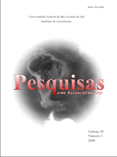Evolução temporal da impactação do Sistema Estuarino de Santos - São Vicente (SP,Brasil) analisada através das populações de foraminíferos sub-recentes.
DOI:
https://doi.org/10.22456/1807-9806.20302Palabras clave:
foraminifera, coastal zone, sediment core.Resumen
Vertical distribution of benthic foraminiferal species in three shallow sediment cores were used to assess environmental changes in Santos – São Vicente Estuarine System during the last decades. The area was chosen due the diversity and complexity of the anthropogenic agents that have been actuating into this ecosystem since the 1950 decade. Although all analyzed cores presented close species composition, suggesting similar depositional environmental conditions, some variability in species importance along the sedimentary column were observed among then. Particular features of each sampled point were thus related to the environmental transformations to explain that. The results obtained for the Cubatão area suggested an upward transition from strongly restrictive ecological conditions (represented by dominance of Ammotium) to a moderately restrictive ones (with the increase in the relative abundance of other taxa, such as trochaminids). This faunal enrichment was interpreted as a result from a recent re-colonization by mangrove trees in the previously degraded exposed banks (due to reduction of chemical pollutant inputs). The area under influence of Santos Harbor was the one that showed the slightest fluctuations in species distribution. Even so, a possible influence of the periodic dredging of the harbor channel on the variations of Ammotium population along the core can be proposed. Finally, the core sampled at the São Vicente Estuary presented ecological indications of a fast increase of marine confinement, probably related to the intense domestic sewage that reach this sheltered portion of the system. The considerations and hypotheses presented in this research pointed out the great potential in the use of bioindicators as a tool for recent and sub-recent environmental evaluation studies. Nevertheless, the inherent methodological restrictions must be keep in mind and complementary ecological studies need to be conducted in order to allow definitive conclusions.



